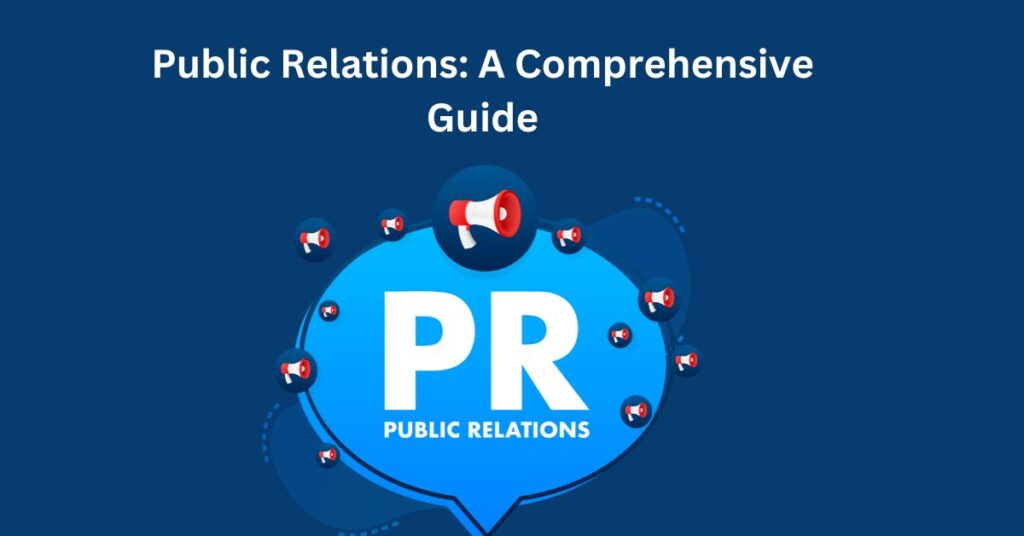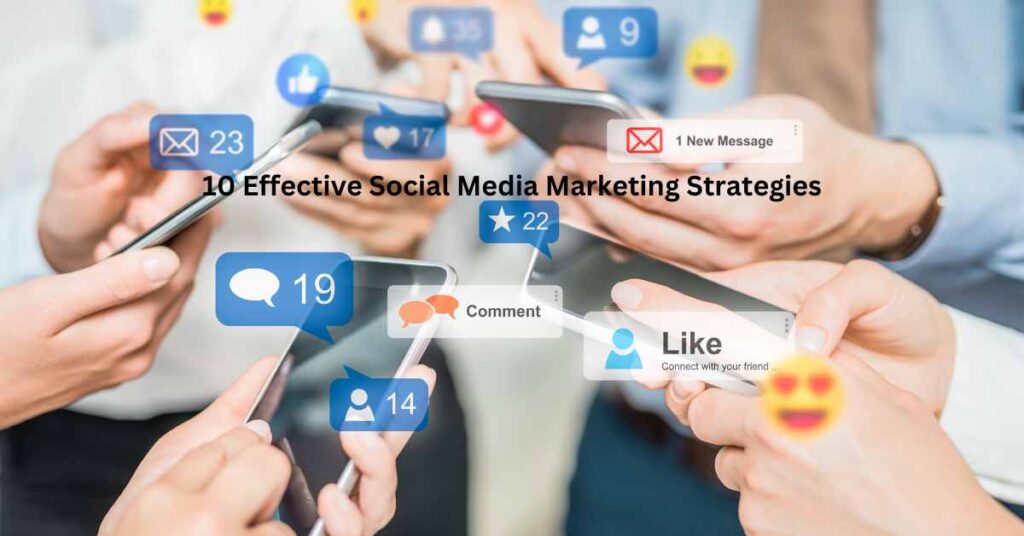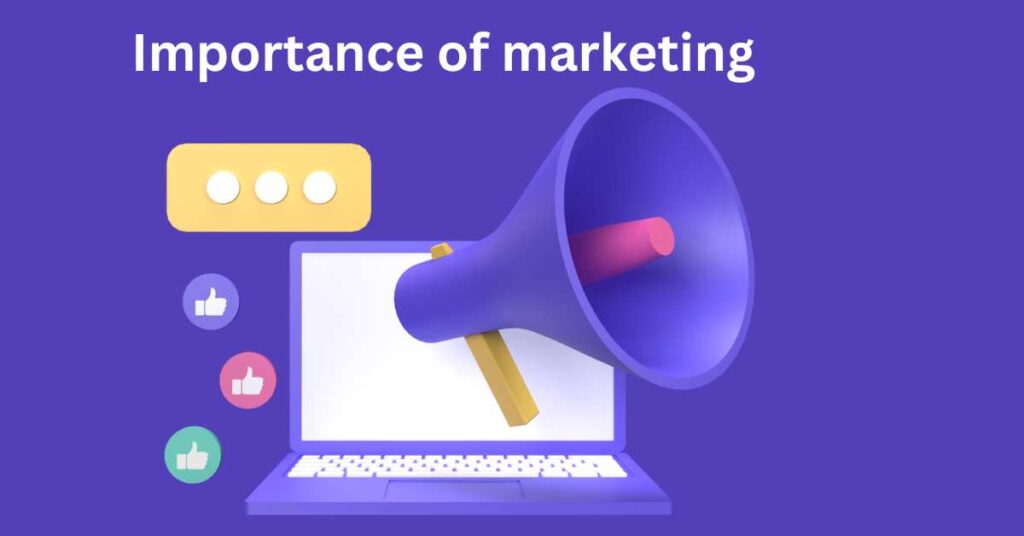Last updated on June 3rd, 2024 at 10:34 pm
If you are an advertiser, entrepreneur, or company owner then public relations can help to bring your company to the next level. Public relations plays an important role in shaping and maintaining a positive image for businesses and brands.
Table of Contents
Today’s businesses and brands place 63% of their value on the public image. According to a recent study, It is known that a bad reputation can be overcome in between 4 to 7 years.
So, businesses or brands must spend their efforts and money on effective public relations methods. This will help to maintain a positive image with the general public.
Public relations (PR) is the best way to protect and enhance the reputation of any company or brand. A company’s survival and growth relies on its reputation in the market.
In short, we can say that public relations is the art of managing communication between a company and its customers. Public relations is an important component of a comprehensive marketing strategy.
In this blog, we will learn the meaning of public relations in marketing with its types, goals, benefits, importance, and some real-world examples.
What is public relations in marketing?
In marketing public relations is known as the practice of maintaining a positive and healthy relationship between organizations and their employees, customers, public, financial partners, markets, and so on.
Public relations (PR) is the kind of strategic communication that businesses, people, and organizations use to create favorable connections with the general public.
A public relations professional uses the media and other direct or indirect ways to maintain a positive brand image and a strong relationship with the target audiences.
PRSA states, ” Public relations (PR) is a strategic communication process for making beneficial relationships between the companies and their publics.”
In the same way, Public relations (PR) creates a positive image by maintaining good relationships between the brands and its various public like customers, investors, employees, media, and the broader community.
Public relations (PR)is different from advertising because it focuses on building good relationships and managing the reputation of the organization.
PR is the process of managing how the public sees and feels about a brand or company, while marketing and advertising focus on the products or services promotion.

The main goal of public relations is to keep a brand’s reputation positive and to maintain positive relationships with the general public, clients, business partners, investors, employees, and other stakeholders. This gives the brand a good reputation and makes it look honest, successful, important, and relevant.
Another important part of public relations is to spread company news or events and maintain a positive brand image through company press releases, news conferences, interviews, social media posts, and so on.
Major Goals of Public Relations
The major goals of the public relations campaign are as follows:
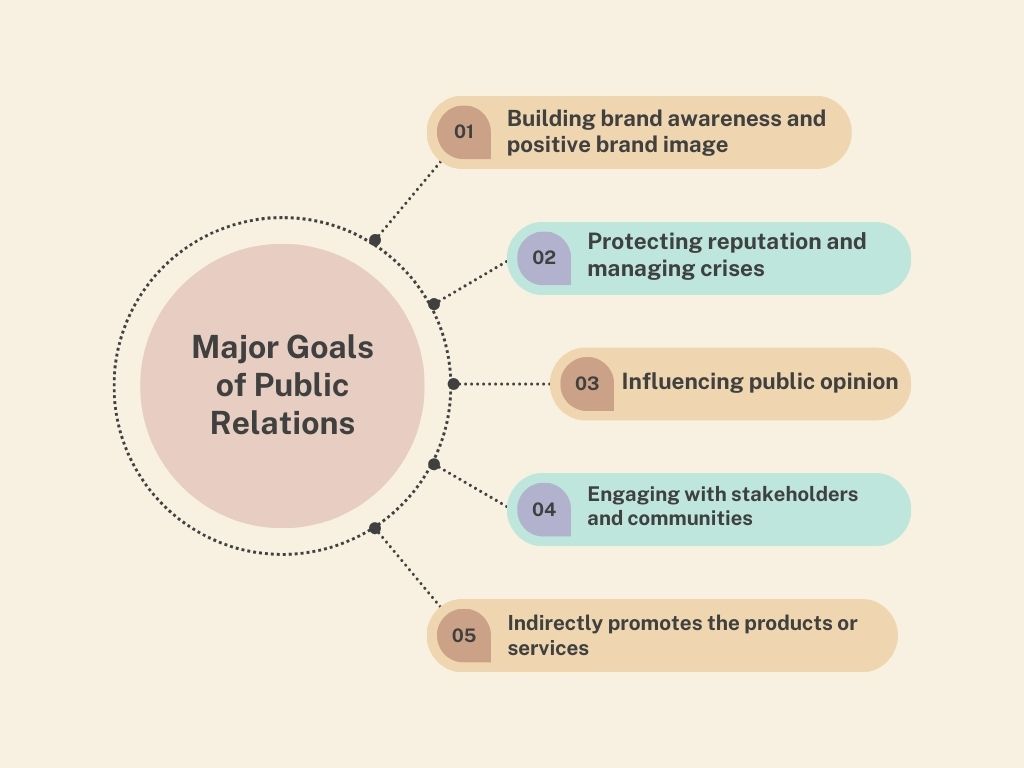
1. Building brand awareness and positive brand image
The main goals of public relations (PR) are to build brand awareness and a positive brand image. Businesses can increase their brand recognition by strategically showcasing a company’s values, innovation, achievements, unique qualities, and so on.
Using media coverage, social media, events, and so on helps a lot in building brand awareness and a positive brand image among the target audience.
2. Protecting reputation and managing crises
In the same way, a company’s growth or survival depends upon its reputation in the market. Public relations plays a crucial role in protecting the reputation of the organization.
Similarly, another major goal of public relations is to manage the crises. Public relations helps to minimize negative events and maintain public trust by using effective crisis communication strategies.
3. Influencing public opinion
Public relations (PR) is the best way to influence the public opinion. Companies can shape public perception by strategically communicating a brand message on various issues.
Public relations helps to maintain good public opinion towards the brands while there are many negative issues and opinions in the public.
4. Engaging with stakeholders and communities
Public relations (PR) is the best way to engage with stakeholders and communities of an organization. It involves the meaningful interaction between a company and its stakeholders, including investors, customers, communities, and employees.
Public relations professionals use many techniques to engage with the stakeholders and communities which is very helpful in enhancing a brand’s credibility.
5. Indirectly promotes the products or services
We know that advertising directly promotes the product or services while public relations (PR) promotes the products or services indirectly. Using storytelling, media coverage, social media, and so on to indirectly promote a brand and its products and services.
Showing the organization’s values, quality, innovation, and others using the different tools helps a lot in promoting the products or services indirectly.
Key Public Relations (PR) Strategies and Tactics
Some of the major key Public relations (PR) strategies and tactics used in PR campaigns are as follows:
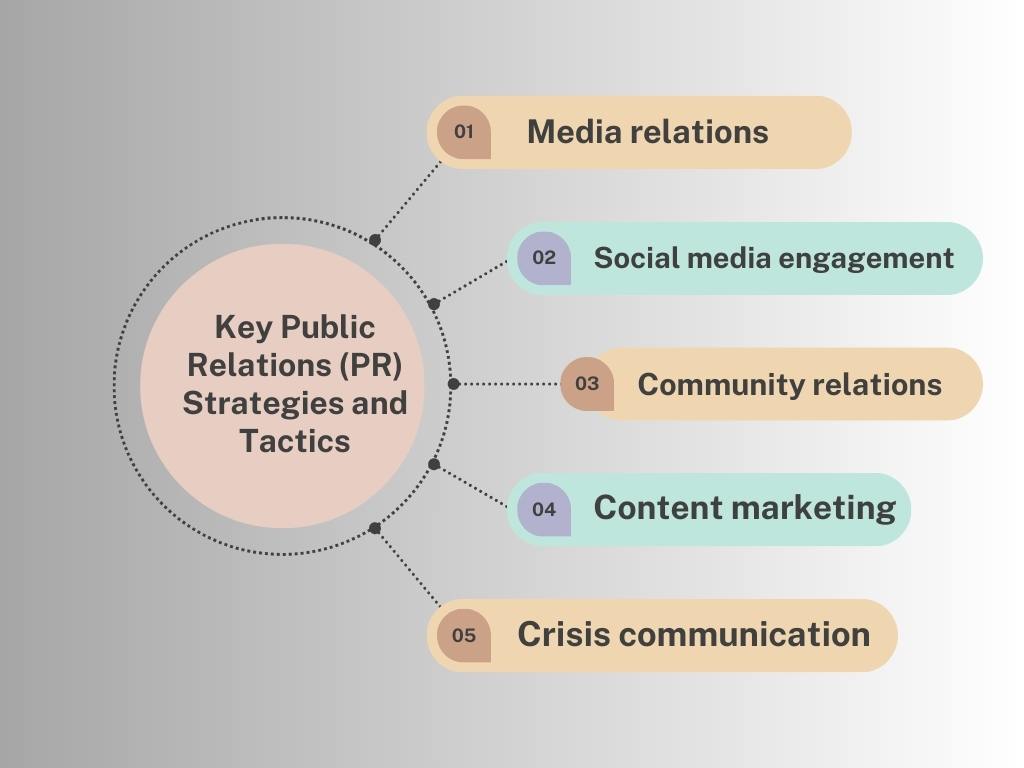
1. Media relations
Public relations plays an important role in managing relationships with the media. With the help of different media, press releases, and other communication tools, companies can secure positive media coverage.
The media relations strategies include maintaining a good relationship with the media and doing activities like telling stories to journalists, holding press conferences, and so on.
2. Social media engagement
Social media plays a very important role in businesses to maintain a good and positive relationship with their customers, stakeholders, employees, investors, and the general public.
The social media engagement strategy in Public relations (PR) involves creating and sharing valuable content on social media and properly interacting with their audiences.
Read 👉 Tips for creating engageable and sharable social media content
3. Community relations
To maintain good and healthy relationships with the audience community relations play a very important role. Public relations is not only about maintaining a good relationship by using the media and social media, it is also about making community relations by being involved physically.
The owners, managers even other people of the company can participate in local events and support community causes. This will help to foster a good relationship with the community and increase the positive brand image.
4. Content marketing
Content marketing is one of the best ways to maintain a good relationship with customers and other stakeholders. With the help of content marketing businesses and brands can gain the trust of their audiences.
In public relations campaigns creating and sharing valuable content such as blogs, articles, videos, and images helps attract and inform the target audiences.
5. Crisis communication
Similarly, crisis communication also plays a very important role while running public relations campaigns. PR professionals need to manage communication to minimize reputational damage because many unexpected challenges or crises arise.
So, it is necessary to develop plans and protocols for quick and effective responses to negative events can be vital in maintaining public trust.
Benefits of Effective Public Relations
The benefits of effective public relations (PR) campaigns are as follows:
1. Helps to increase brand awareness and trust

The main benefits of effective public relations are to create brand awareness and visibility for a brand. In the same way, public relations is one of the effective ways to gain the trust of the customers and other stakeholders.
By using media coverage, events, social media, and other initiatives businesses can boost their brand visibility and brand awareness among the customers and its stakeholders.
2. Improved customer loyalty and sales

Public relations is about maintaining a positive relationship with the customers. This process helps to improve customer loyalty toward brands. Public relations helps to gain trust from the customers and this will lead to increased loyalty from the customers.
In the same way, another benefit of public relations is helps to improve sales. PR is the silent advertiser of the product or services. Public relations helps to promote products or services indirectly which leads to an increase in sales.
3. Helps to enhance employee morale and recruitment

Public relations (PR) is a powerful tool to enhance employee morale and recruitment. Effective public relations attracts the top talents in the company. Communicating a company’s values, culture, innovations, and so on helps to enhance employee morale.
In the same way, with effective public relations potential recruits are attracted to organizations. So, PR helps to enhance the motivation of the existing employees and attract the top talents in the company.
4. Positive media coverage and reputation

Positive media coverage is very important For maintaining good relationships with customers, stakeholders, and the public. This will directly impact on the reputation of the company.
Showcasing the company’s success, values, innovation, qualities, and other positive initiatives helps to maintain a favorable reputation. Positive media coverage plays a very important role in building brand awareness and helps maintain the company’s good reputation.
In the same way, positive media coverage helps to get a positive public perception of the brand and an impactful reputation in the eyes of stakeholders.
5. Differentiation from others

Public relations is a very powerful tool for differentiating the brand and its products or services from the others. In this competitive marketplace, it is essential to stand out by showing the unique qualities and values of the company.
Effective public relations helps to differentiate the brands from the other competitors so this will help to attract the customers and retain customers.
Real-World Examples of Successful PR Campaigns
There are many real-world examples of successful Public relations (PR) campaigns. Let’s see some of the popular PR campaigns:
Google’s fight Ebola campaign
In 2014, Google launched a donation campaign to fight the Ebola virus where it was spread among many countries and took many lives. If every dollar people donate through its site, Google decided to donate two dollars.
This campaign was very successful and helped the people in need and helped to build a positive brand image.
Share a Coke Campaign
Share a Coke is another popular successful public relations (PR) campaign. This was started in Australia. The brand image of Coca-Cola in Australian teen people was decreased. Teens and adults started to think the brand was outdated.
To create a positive brand image and build brand awareness the Australian Coca-Cola teams start a Share a Coke campaign. The main goals of this campaign are to increase sales among young consumers and bring the brand closer to Australian young adults. In this campaign. The company started to print the names of the people in the product.
The plan involved changing the labels on every single product they sell. Every bottle of Coca-Cola was replaced by the traditional logo with share a Coke followed by one of the 150 most popular names in Australia.
By using that plan Coca-Cola became popular on social media and among young people. Effective implementation of the Share a Coke using billboards, social media, online ads, and so on was helpful to reconnect with the people again.
You May Also Like to Ask
In simple terms, public relations (PR) is the strategic practice of maintaining a positive and healthy relationship between an organization and its audiences. Public relations is about building relationships, influencing public opinion, and protecting the reputation of the company.
Some of the most common types of public relations are media relations, community relations, crisis communications, internal communications, investor relations, and so on.
Public relations is about managing and maintaining the overall reputation of an organization while advertising or marketing focuses on promoting products or services to increase sales volume. The main aim of public relations (PR) is to build relationships and create a positive public image.
The cost of public relations campaigns can vary depending on the size of an organization, industry, scope, and so on. Similarly, there are many free and low-cost public relations activities such as using social media, content marketing, and writing press releases.
There are several methods of measuring the success of public relations (PR) campaigns such as changes in sales volume, website traffic, media coverage, social media engagement, and so on.
Yes, Small businesses can also get a lot of benefits from public relations. Small businesses can implement PR campaigns to increase brand visibility, manage their reputation, and connect with their target customers effectively.
Conclusion
Public relations is an important part of the marketing mix. It plays a very important role in the survivability and growth of any organization. Public relations (PR) plays a vital role in shaping a brand’s identity and fostering a positive relationship with its audiences.
Public relations helps to maintain positive and healthy relationships between organizations and their employees, customers, the public, financial partners, markets, etc. In short public relations is the practice of making beneficial relationships between companies and their publics.
The main goals of public relations (PR) are to keep a brand’s reputation positive, manage the crisis, build a positive brand image, Influence public opinion, maintain positive relationships, and so on.
some of the major Public relations (PR) strategies and tactics used in PR campaigns are media relations, social media engagement, community relations, crisis management, and so on.
In the same way, public relations is very beneficial for increasing sales, brand awareness, and trust, helping to maintain a positive reputation, and so on.
At last, we can conclude that Leveraging the power of public relations (PR) remains essential for the company’s growth and survival.
Thanks for reading. If you have any suggestions or questions related to public relations feel free to leave a comment below.
